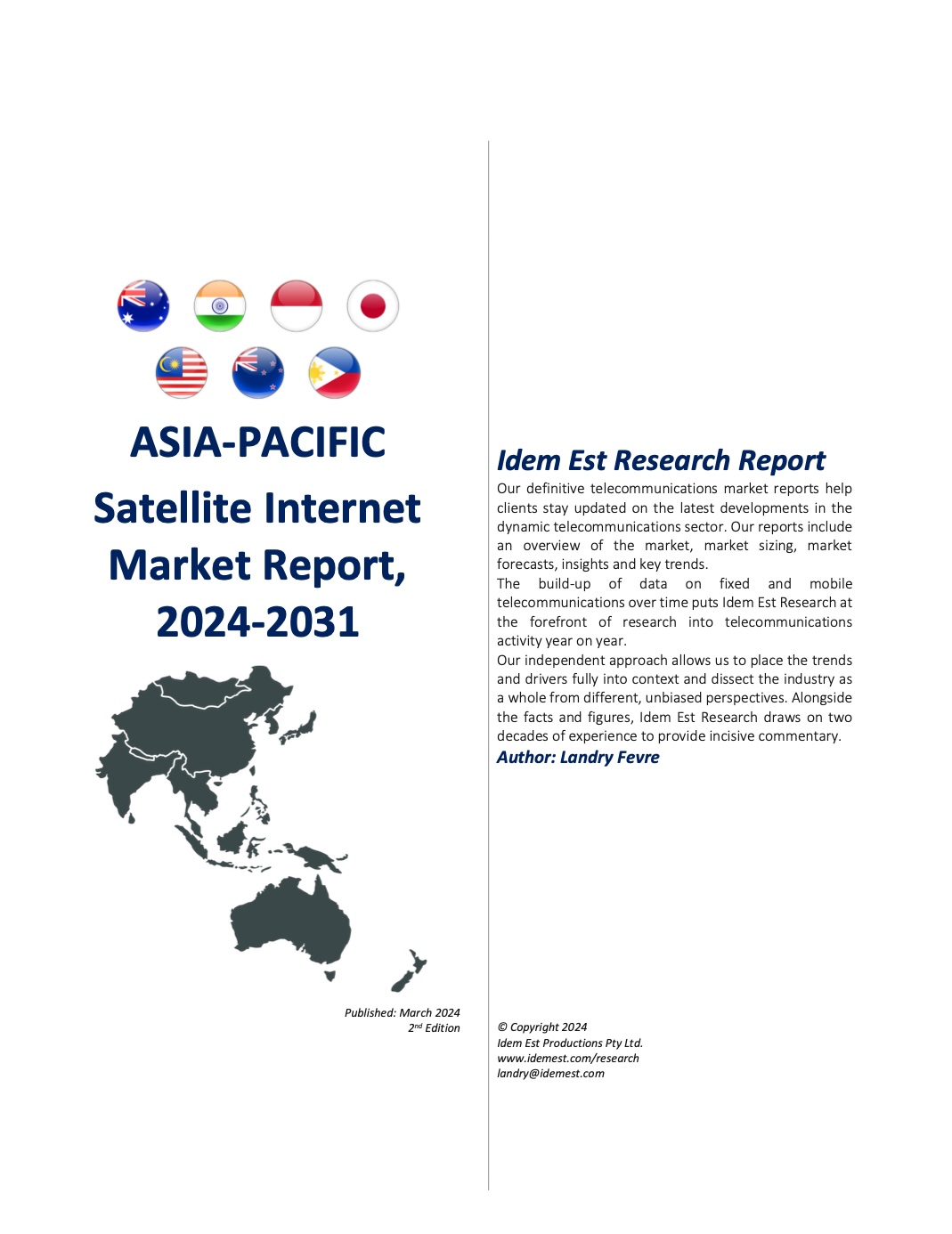Your cart is currently empty!
Asia Pacific Satellite Internet Market Report, 2024-2031
This Asia Pacific Satellite Internet Market Report provides analyses of revenue and market forecasts as well as statistics of the Asia-Pacific satellite broadband industry including market sizing, 7-year forecasts, market insights, key satellite trends, LEO/MEO/GEO satellite developments and also features the following: Overall Satellite Subscriber Market Share by Country and Providers Satellite Internet Providers Profile (Starlink, Kuiper, OneWeb, AST SpaceMobile, Lynk Global, GW China among others) Satellite Internet Competitive Landscape Countries covered: Australia, India, Indonesia, Japan, Malaysia, New Zealand, Philippines Satellite Internet Subscribers, Market Share & Forecasts (including Starlink subscribers by country) 5G NTN: The Next Generation of Satellite Connectivity Regulatory…
Description
WHY YOU SHOULD BUY THE ASIA PACIFIC SATELLITE INTERNET MARKET REPORT:
- Benefit from the latest market opportunities
- Understand the threats to your operations and investments and protect your company against future risks
- Gain insights on emerging trends supporting, enhancing or disrupting your activities in the market
- Get a full view of the competitive landscape to assess your market position.
- Forecasts as a key input for successful budgeting and strategic business planning in the telecoms market
- Target business opportunities and risks in the telecoms sector through our reviews of latest industry trends, regulatory changes and major deals, projects and investments
- Assess the activities, strategy and market position of your competitors, partners and clients via our Satellite Internet Operators Profiles
The Asia Pacific Satellite Internet Market Report, 2023-2030 includes a comprehensive review of the Asia Pacific region satellite Internet market dynamics, market sizing, market forecasts, analysis, insights and key trends.
EXECUTIVE SUMMARY
Asia Pacific Satellite Internet Market Report at a Glance
The Asia Pacific has seen rapid growth in satellite broadband connectivity, driven by the region’s unique geography, increasing demand for internet access, and advancements in technology. Key factors in this evolution include technological innovations, changes in regulations, and the drive of industry players.
In 2023, there were approximately 616k satellite broadband subscribers in the region. Australia had the most subscribers, where Starlink dominated, taking users from NBN. India came second with legacy providers like Hughes Communications and Nelco with significant subscribers. By December 2023, Starlink had launched in 60 countries globally, with a significant presence in the Asia Pacific.
Data shows that the number of satellite broadband subscribers in the Asia Pacific is projected to grow at a significant growth rate. Australia led the market in 2023, but India is anticipated to emerge as the primary market by 2024, contingent on the government’s spectrum pricing for LEO satellite projects. The growth rate, particularly with LEO satellites, is expected to be substantial during this forecast period.
The report also covers the latest developments with 5G NTN (Non-Terrestrial Networks) which integrates the fifth generation of mobile networks with entities like satellites, high-altitude platforms, and unmanned aerial systems, enabling broader and more resilient communication. Designed to address geographic connectivity limitations, it acts as an alternative in rural or challenging terrains, and serves as a backup during disasters. On the technical front, 5G NTN operates on various frequency bands and promises competitive latency due to LEO satellites. It has potential applications for IoT, broadband distribution, and device-centric communication. Despite its promise, challenges include the capital-intensive nature of satellite deployments, regulatory concerns, and competition from advancing terrestrial networks. As for providers, Starlink, AST Space Mobile, Kuiper, and others have diverse offerings. The distinction between geostationary orbit (GEO) and low earth orbit (LEO) satellites is crucial; while GEOs cover larger areas, LEOs, being closer to Earth, offer lower latency but require more satellites for comprehensive coverage.
In terms of revenue, Idem Est Research estimates that satellite Internet operators will generate over USD1 billion million in 2024 following Starlink’s regional launch. This figure is forecasted to grow significantly by 2030, with an average annual growth rate of 50.2%. However, the growth of the satellite broadband market is intertwined with regulatory challenges and the limited availability of spectrum. As demand for spectral frequencies grows, competition becomes fierce. Different nations have unique regulatory frameworks, and navigating these regulations is challenging. Satellite broadband providers face stringent rules to prevent interference with existing services. Thus, entering this market means not just having the technology but also understanding various licensing requirements. As the need for spectrum resources grows with technological advancements, efficient strategies, international collaborations, and dynamic allocation will be essential in the next decade.
Starlink, under SpaceX (founded by Elon Musk), aims to provide global high-speed, low-latency internet connectivity via a satellite constellation in low Earth orbit (LEO).
| Region | Sep-23 | Dec-23 | Jan-24 | Feb-24 | |
|---|---|---|---|---|---|
| Africa | 51 | 64 | 65 | 79 | |
| Asia | 52 | 58 | 62 | 74 | |
| Central America | 55 | 65 | 61 | 65 | |
| Europe | 299 | 301 | 276 | 297 | |
| North America | 1,119 | 1,365 | 1,612 | 1,835 | |
| Oceania | 157 | 197 | 204 | 222 | |
| South America | 217 | 165 | 171 | 166 | |
| Total | 1,987 | 2,216 | 2,452 | 2,739 |
As of September 2023, over 5,000 satellites have been launched out of a proposed 12,000 to 42,000, with launches happening every 4-5 days. Each satellite has a lifespan of approximately 3.5 years. An upcoming “Gen 2” network promises enhanced speeds and user capacity.
In just 3 years, Starlink has become the leading entity in the global broadband satellite market. Idem Est Research reports that by September 2023, Starlink had nearly 4 million subscribers globally, with the largest markets being in North America and about 430k subscribers in the Asia Pacific region. Idem Est Research estimates Starlink 2023 revenues to surpass USD2 billion.
In the Asia-Pacific region, Starlink has formed partnerships with companies like KDDI in Japan, Data Lake and PT&T in the Philippines and Telstra, Vocus, and Optus in Australia for various services such as 4G & 5G backhaul and broadband resale.
Crucially, the Starlink project intersects with geopolitics; its comprehensive satellite coverage raises concerns about digital sovereignty, especially given Musk’s decisive control over its use, as evidenced by his refusal to allow its use in certain military applications. Facing a blend of regulatory challenges and potential strategic partnerships worldwide, Starlink’s dominance in space infrastructure positions it as both a soft power tool for the U.S. and a potential source of space traffic concerns. While primarily commercial, Starlink’s deep intertwining with global geopolitics is increasingly evident as it redefines connectivity norms.
Satellite broadband’s potential in the Asia Pacific is immense. By diving deep into its market dynamics, socioeconomic impacts, environmental considerations, technological evolution, and the importance of policies and collaboration, this report offers a comprehensive overview of the opportunities and challenges the region faces.
KEY COMPANIES MENTIONED IN THIS ASIA PACIFIC SATELLITE INTERNET MARKET REPORT:
AST Spacemobile, Eutelsat, Globalstar, Inmarsat, IPStar, Kacific, Kuiper, Lynk, Measat, NBN, OneWeb, SpaceX, Starlink, Viasat.
Asia Pacific Satellite Internet Market Report – Table of Contents
1 The Race For The Last 5%
2 Satellite Internet Connectivity: An Overview
2.1 Satellite Internet Basics
2.2 Comparing LEO, MEO, and GEO Satellite Orbits
2.2.1 LEO and GEO Satellite Comparison
2.3 Satellite Frequency Bands
2.3.1 Ku-band
2.3.2 Ka-band
2.3.3 C-band
2.3.4 L-band
2.3.5 Other Satellite Bands
2.4 Satellite Broadband Providers Operators, 2023
3 5G NTN: The Next Generation of Satellite Connectivity
3.1 5G NTN Overview
3.1.1 The Rationale Behind 5G NTN
3.1.2 Technical Aspects of 5G NTN
3.1.3 Potential Applications for 5G NTN
3.1.4 Challenges in Implementation
3.2 5G NTN Satellite Providers
4 Asia Pacific Satellite Broadband Market Analysis, 2023-2031
4.1 Market LandscaPe of Satellite Broadband Subscribers, 2023
4.2 Asia Pacific Satellite Broadband Subscribers Forecast, 2023-2031
4.3 Overall Satellite Broadband Revenue Forecast, 2023-2031
4.4 Regulatory Challenges and Spectrum Allocation
5 Satellite Operators Profile
5.1 Starlink Profile
5.1.1 Starlink Satellite Launches per Year
5.1.2 Starlink Geopolitical Clout
5.1.3 Starlink Subscribers and Revenue Estimates
5.1.1 Starlink Partnerships in Asia Pacific
5.2 Starlink Technology & Capacity
5.3 Starlink Direct to Cell
5.4 Starlink Subscriber Estimates
5.4.1 Starlink Partnerships in Asia Pacific, 2023
5.5 Project Kuiper Profile
5.6 Eutelsat OneWeb Profile
5.7 AST Space Mobile Profile
5.8 Lynk Profile
5.9 OTHER LEO Constellation Projects
5.9.1 China’s Guo Wang (GW) Constellation
5.96.2 India Satellite Internet Key Players
5.9.3 Key Challenges and Considerations for New Entrants:
6 Evaluating the Impact of Satellite Broadband Connectivity in the Asia Pacific
6.1 Socioeconomic Impact
6.2 Environmental Considerations
7 Future Prospects of Satellite Broadband and 5G NTN
7.1 Expanding Geographical Reach
7.2 Addressing Infrastructure Limitations
7.3 Enhancing Data Throughput and Latency
7.4 Facilitating the Internet of Things (IoT) and Edge Computing
7.5 Disaster Recovery and Emergency Services
8 Conclusion
9 Methodology
10 Copyright Notice
Asia Pacific Satellite Internet Market Report – List of Figures
Figure 1 – Satellite Deployments Type
Figure 2 – Satellite frequency bands
Figure 3 –Starlink and OneWeb Satellite Launches per Month (Data until Jan-23)
Figure 4 –Australia Satellite Broadband Market Share, 2023
Figure 5 – Asia Pacific Satellite Broadband Subscribers Distribution by Country, 2023
Figure 6 – Asia Pacific Satellite Broadband Subscribers Distribution by Country, 2023
Figure 7 – Asia Pacific Satellite Broadband Subscribers Forecast, 2023-2031
Figure 8 – Asia Pacific Satellite Broadband Revenue Forecast, 2023-2031
Figure 9 –Satellite Launches including Starlink per Year (Data until Dec-23)
Asia Pacific Satellite Internet Market Report – List of Tables
Table 1 – Satellite Orbit Altitudes
Table 2 – LEO and GEO Satellite Comparison
Table 3 – Satellite Broadband Subscribers Operators, 2023
Table 4 – 5G NTN and Satellite Providers, 2023
Table 5 – Asia Pacific Satellite Broadband Subscribers by Operators and Countries, 2023
Table 6 – Asia Pacific Satellite Broadband Subscribers Forecast, 2023-2031
Table 7 – Asia Pacific Satellite Broadband Revenue Forecast, 2023-2031
Table 8 – Starlink Global Subscriber Database, as of December 2023
Other Idem Est Research Telecoms Country Reports
Australia, Bangladesh, China, India, Indonesia, Japan, New Zealand, Malaysia, Myanmar, Pakistan, Philippines, Singapore, South Korea, Taiwan, Thailand, Vietnam,
Asia Pacific Telecom Towers, Asia Pacific Satellite Internet, Starlink Company Profile
Additional information
| Bundle | Report, Market Data, Report + Market Data |
|---|





